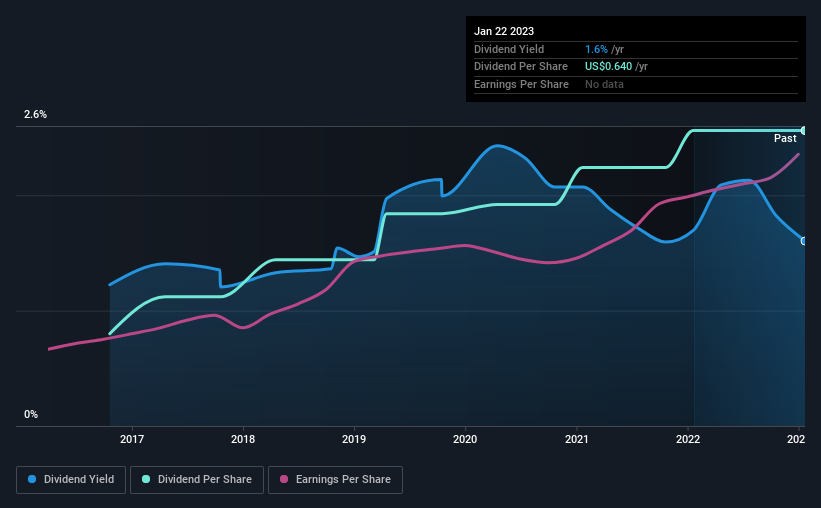- United States
- /
- Banks
- /
- NasdaqCM:PLBC
Plumas Bancorp's (NASDAQ:PLBC) Shareholders Will Receive A Bigger Dividend Than Last Year
Plumas Bancorp (NASDAQ:PLBC) has announced that it will be increasing its periodic dividend on the 15th of February to $0.25, which will be 56% higher than last year's comparable payment amount of $0.16. Although the dividend is now higher, the yield is only 1.6%, which is below the industry average.
Check out our latest analysis for Plumas Bancorp
Plumas Bancorp's Earnings Will Easily Cover The Distributions
If it is predictable over a long period, even low dividend yields can be attractive.
Plumas Bancorp has a good history of paying out dividends, with its current track record at 6 years. Using data from its latest earnings report, Plumas Bancorp's payout ratio sits at 14%, an extremely comfortable number that shows that it can pay its dividend.
If the trend of the last few years continues, EPS will grow by 22.5% over the next 12 months. If the dividend continues on this path, the future payout ratio could be 16% by next year, which we think can be pretty sustainable going forward.

Plumas Bancorp Doesn't Have A Long Payment History
Even though the company has been paying a consistent dividend for a while, we would like to see a few more years before we feel comfortable relying on it. Since 2017, the annual payment back then was $0.20, compared to the most recent full-year payment of $0.64. This works out to be a compound annual growth rate (CAGR) of approximately 21% a year over that time. It is always nice to see strong dividend growth, but with such a short payment history we wouldn't be inclined to rely on it until a longer track record can be developed.
The Dividend Looks Likely To Grow
Investors who have held shares in the company for the past few years will be happy with the dividend income they have received. We are encouraged to see that Plumas Bancorp has grown earnings per share at 23% per year over the past five years. Earnings per share is growing at a solid clip, and the payout ratio is low which we think is an ideal combination in a dividend stock as the company can quite easily raise the dividend in the future.
We Really Like Plumas Bancorp's Dividend
Overall, a dividend increase is always good, and we think that Plumas Bancorp is a strong income stock thanks to its track record and growing earnings. Earnings are easily covering distributions, and the company is generating plenty of cash. All of these factors considered, we think this has solid potential as a dividend stock.
Investors generally tend to favour companies with a consistent, stable dividend policy as opposed to those operating an irregular one. Still, investors need to consider a host of other factors, apart from dividend payments, when analysing a company. For example, we've picked out 1 warning sign for Plumas Bancorp that investors should know about before committing capital to this stock. If you are a dividend investor, you might also want to look at our curated list of high yield dividend stocks.
New: Manage All Your Stock Portfolios in One Place
We've created the ultimate portfolio companion for stock investors, and it's free.
• Connect an unlimited number of Portfolios and see your total in one currency
• Be alerted to new Warning Signs or Risks via email or mobile
• Track the Fair Value of your stocks
Have feedback on this article? Concerned about the content? Get in touch with us directly. Alternatively, email editorial-team (at) simplywallst.com.
This article by Simply Wall St is general in nature. We provide commentary based on historical data and analyst forecasts only using an unbiased methodology and our articles are not intended to be financial advice. It does not constitute a recommendation to buy or sell any stock, and does not take account of your objectives, or your financial situation. We aim to bring you long-term focused analysis driven by fundamental data. Note that our analysis may not factor in the latest price-sensitive company announcements or qualitative material. Simply Wall St has no position in any stocks mentioned.
About NasdaqCM:PLBC
Plumas Bancorp
Operates as the bank holding company for the Plumas Bank that provides various banking products and services for small and middle market businesses and individuals in California, Nevada, and Oregon.
Flawless balance sheet and undervalued.
Similar Companies
Market Insights
Community Narratives




